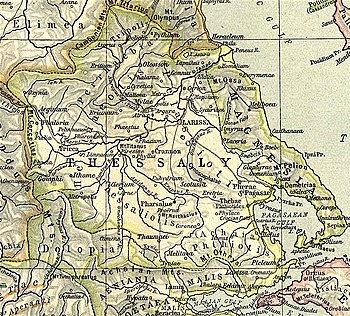Methone (Thessaly)

Methone (Ancient Greek: Μεθώνη, Methṓnē) was an ancient Greek city-state[1] on the Pagasetic Gulf of Magnesia in ancient Thessaly.[2][3][4][5] The town is mentioned by Homer in the Catalogue of Ships in the Iliad as belonging to Philoctetes.[6] It is also mentioned in the Periplus of Pseudo-Scylax as a city in Magnesia, together with Iolcus, Coracae, Spalauthra and Olizon.[7]
Some accept that the town's location is on a hill called Nevestiki (39°19′54″N 23°03′10″E / 39.3316°N 23.0527°E), near the current village of Ano Lechonia,[8][9] where remains of a fortification have been found, but that location has been suggested by others as the site of Coracae.[10]
References
[edit]- ^ Mogens Herman Hansen & Thomas Heine Nielsen (2004). "Thessaly and Adjacent Regions". An inventory of archaic and classical poleis. New York: Oxford University Press. pp. 720–721. ISBN 0-19-814099-1.
- ^ Periplus of Pseudo-Scylax, p. 25
- ^ Strabo. Geographica. Vol. ix. p.436. Page numbers refer to those of Isaac Casaubon's edition.
- ^ Pliny. Naturalis Historia. Vol. 4.9.16.
- ^ Stephanus of Byzantium. Ethnica. Vol. s.v.
- ^ Homer. Iliad. Vol. 2.716.
- ^ Periplus of Pseudo-Scylax, 65.
- ^ Richard Talbert, Barrington Atlas of the Greek and Roman World, (ISBN 0-691-03169-X), Map 55.
- ^ Lund University. Digital Atlas of the Roman Empire.
- ^ Mogens Herman Hansen & Thomas Heine Nielsen (2004). "Thessaly and Adjacent Regions". An inventory of archaic and classical poleis. New York: Oxford University Press. pp. 719–720. ISBN 0-19-814099-1.
![]() This article incorporates text from a publication now in the public domain: Smith, William, ed. (1854–1857). "Methone". Dictionary of Greek and Roman Geography. London: John Murray.
This article incorporates text from a publication now in the public domain: Smith, William, ed. (1854–1857). "Methone". Dictionary of Greek and Roman Geography. London: John Murray.
